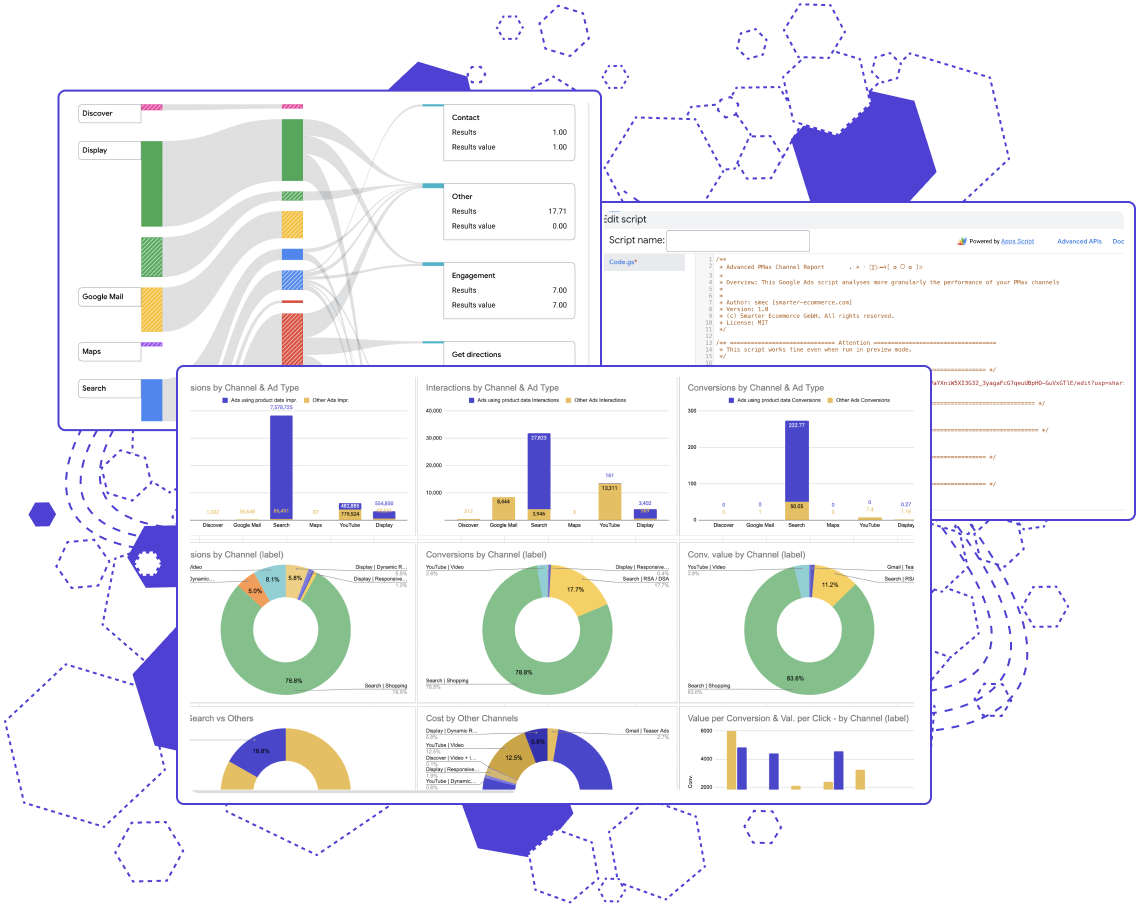Subscribe to join thousands of other ecommerce experts

Believe it or not, it has been three years since Google started the wide-scale rollout of Performance Max campaigns. Time flies when you’re having fun maxing performance.
When PMax first premiered, it was described as a black box – par for the course with new Google tech – but also, more concerningly, as “half-baked,” “unfinished,” “not ready,” and “an experiment funded by advertisers.”
Stinging criticism, and actually quite fair.
Table of Contents
Table of contents
Performance Max campaigns:
Where did we come from?
For example, at its 2022 launch, PMax lacked reporting for item IDs, auction Insights, asset groups and assets, impression share, search terms, and A LOT more.
It was hard to know which of these absences were planned (read: black box), and which were a consequence of rushing the technology out the door.
However, three years on, PMax has become a mature campaign type.
Google has added a wide array of reporting and control options, including some that feel like genuine concessions toward advertisers. In short – if you ask me – PMax is healing.
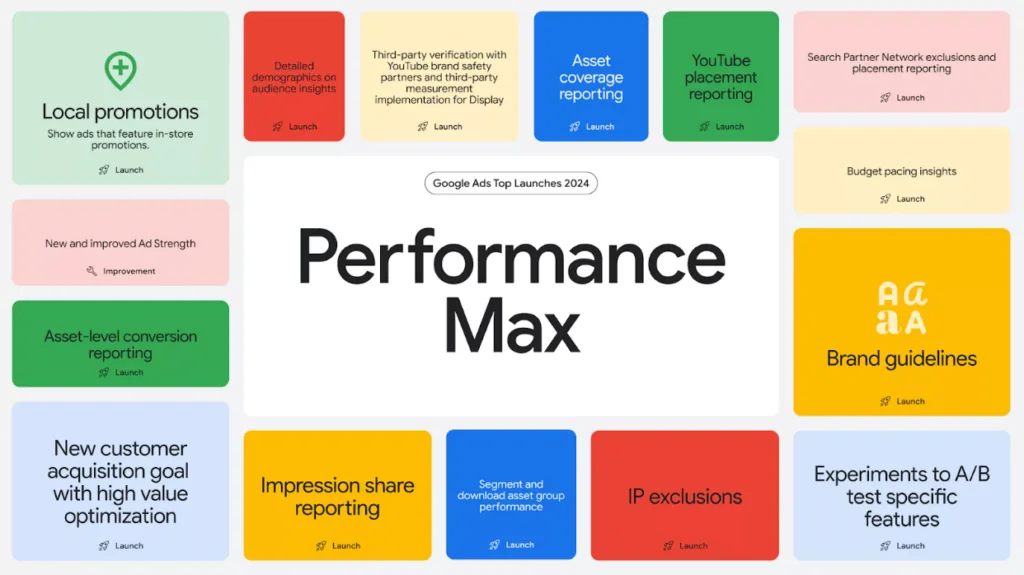
Where did we go?
Having said that, it remains fair to have concerns about PMax, and it remains our duty to voice those concerns to Google. This report aims to be neither a hitpiece nor a whitewash.
In order to understand the evolution of PMax’s role within the Google Ads ecosystem, and the ways ecommerce advertisers continue to adapt to this highly-automated approach, I’ve analyzed thousands of PMax retail campaigns across over 500 advertiser accounts.
I’ve charted my findings below, and also spoken with several top advertising and ecommerce experts.
I’ll focus first on PMax adoption, features, and interactions with other campaign types; and secondly on the way PMax is used by advertisers, and which tactical lessons we can derive.
Without further ado, let’s grow!
1. Performance Max campaign adoption
For years, Google has introduced ever more automation within their ad suite, and they’ve cleverly learned how to make sure each generation of technology stands on the shoulders of the past generation. This helps to avoid losing ground (budget share) that they would have to then regain.
There was probably never a better example than Performance Max campaigns leapfrogging Smart Shopping campaigns.
Introduced in 2018, Smart Shopping was one of Google’s first cross-network technologies – advertising not only within Shopping but also pursuing dynamic remarketing and dynamic prospecting conversions across Google Display, YouTube, and Gmail.

Then, in 2022, Google migrated (“upgraded” in Googlish) the Smart Shopping campaignsubtype into the new Performance Max campaign type. This ripped a MASSIVE chunk of ecommerce ad spend away from Shopping in an incredibly fast way.
Key findings:
- Almost overnight, PMax had a large – arguably unearned – market share.
- It took a year longer than communicated for Google to fully sunset Smart Shopping.
- PMax cost share peaked in May 2024 at just shy of 82%.
- It has since lost an average of .65% cost share per month, nearly 6% in total.
Are PMax’s best days over?
I asked my longtime Google Shopping friend Kirk Williams for input, and he didn’t mince words at all.
“Has PMax jumped the shark?
IMO, it has.
We've never seen PMax perform consistently worse than it has moving into 2025, with little to no strategy shifts on our end.
We have begun transitioning to Search and Standard Shopping more purposefully with obvious revenue and efficiency increase. We went from PMax being the major strategy for our Ecom clients, to a decreasingly important one.
This was not due to a philosophy shift but simply following the numbers.”

Kirk Williams
Owner ZATO
I think Kirk’s dissatisfaction is felt by many – and nothing shows this better than the movement of costs shown above.
However: While it’s rare for me to disagree with Kirk, I for one am cautiously optimistic about the future of PMax. Largely thanks to Google’s recent and upcoming feature releases.
2. The case for Performance Max
As stated, I want this report to take… not necessarily a balanced, but a fair look at Performance Max campaigns.
So, in all fairness, I have to say that Google has been working hard to meet advertisers in the middle on PMax features. Concessions that were unimaginable in 2022 are becoming a reality now, from negative keywords to channel reporting.
To demonstrate that, I’d like to compare the features between Standard Shopping, Smart Shopping, and Performance Max. Please note that I’ve included future releases as well. Crosses (✕) indicate the feature is missing, while a tilde (~) indicates partial feature parity.
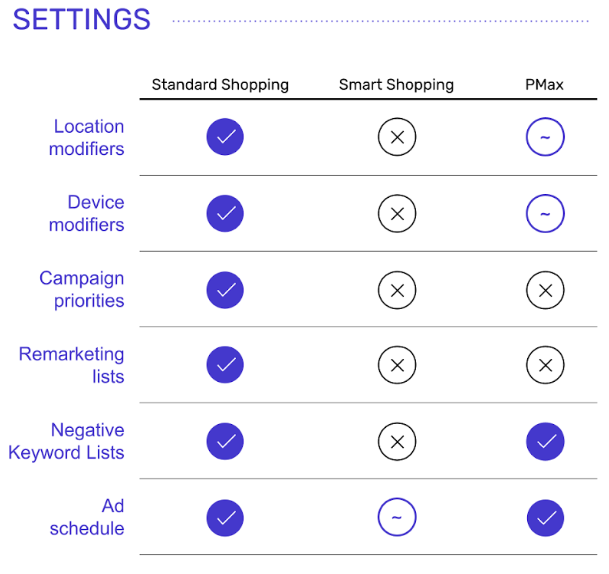
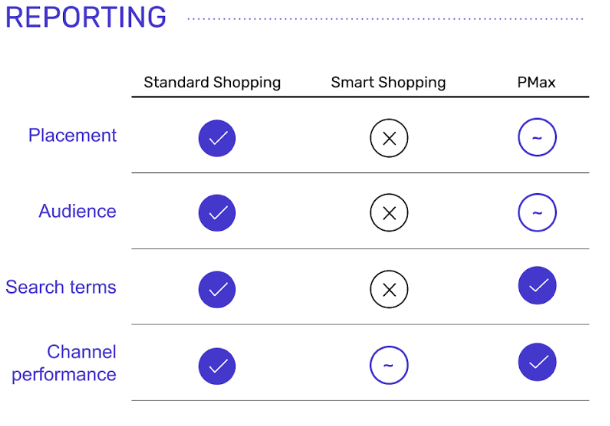
I hope this table reminds you just how poor the features were for Smart Shopping, and how far we’ve come with PMax.
I’m not saying it’s a perfect technology. Given the chance, I would build it differently. However, Google is listening and seems determined to ship features that will drive adoption.
“Google gets a lot of credit here with PMax!”
I asked Greg Finn, Head of Performance & Innovation at Cypress North and co-host of the Marketing O’Clock podcast where he stands.
"Google gets a lot of credit here with PMax.
The product had many, many flaws on launch, but the team has addressed many of the major issues and turned Performance Max into a tool that most marketers can use.
Conversion quality should be a focus if using it for Lead Gen, and the Brand Exclusions and the addition of negative keywords can now help you cut off PMax's reliance on brand spend to find success."

Greg Finn
Head of Performance & Innovation
Cypress North
Does Performance Max actually work?
Performance Max is one of Google’s most controversial, yet most successful, technologies.
In general we’ve seen that Smart Bidding has improved massively over the years, and it is also one of the key drivers of Performance Max campaigns. The controversial part is that, for Smart Bidding to work at peak efficiency, it needs as much budget as possible, and as few constraints as possible.
For Google, it is a happy coincidence that both their data science team and their finance team want the same thing: a blank check (crudely put).
So, yes, PMax works – PMax works quite well – but you might not like how it works.
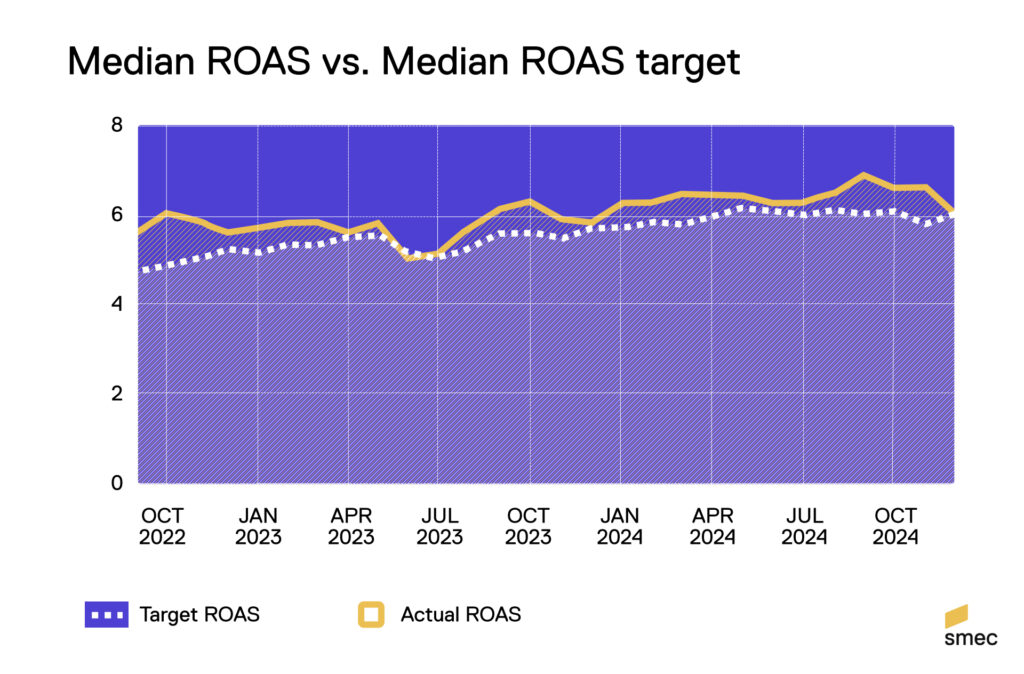
Source: smec
Here I am charting ROAS over time, which by and large PMax delivers beautifully! Yet, personally, we are a bunch of ROAS haters. My problem with Performance Max campaigns is that they work too well. It’s kind of a “be careful what you wish for” scenario.
When you max performance, you will find that the campaign is necessarily scaling into warm traffic: bestselling products, remarketing, and brand search. That’s because these types of traffic all convert really well.
However, the actual job of any given marketing channel is to work hard for your business. The hard work of incremental marketing isn’t always pretty and doesn’t always scale well.
Key findings:
- Advertisers have been increasingly demanding of PMax, and, broadly speaking, PMax has delivered.
- The median Performance Max campaign ROAS target has increased from about 4.7 to about 6.0.
- PMax typically achieves 95% to 116% of the target, although with plenty of exceptions.
- By the numbers, PMax works, but in-platform data always needs to be verified against back-end outcomes.
Back in 2022 I wrote,
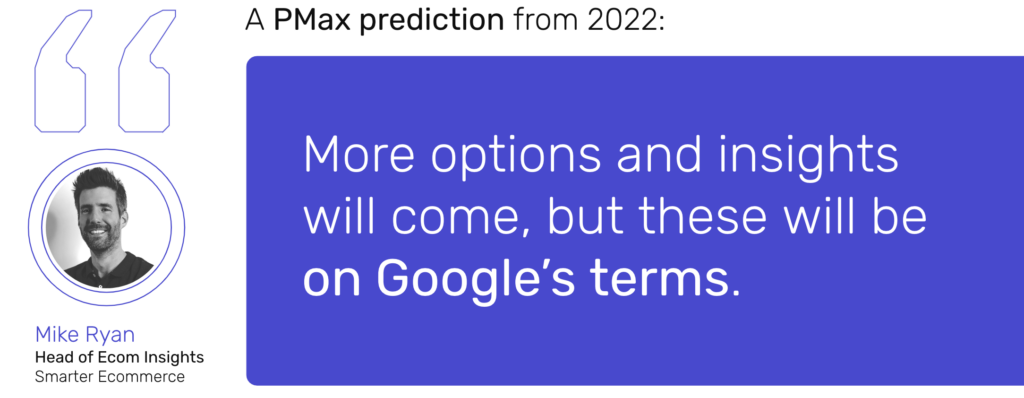
Yet these features are increasingly on advertisers’ terms – and that’s great news.
I think there’s a very real sense in which PMax’s market share is artificial, and Google is now fighting to hold the line. This is beneficial to advertisers.
I just have one… little… well… conspiracy theory. I’ll just post a question:
What if Google is increasing PMax’s feature parity with Standard Shopping in order to justify deprecating Standard Shopping?
3. PMax v. Standard Shopping v. Demand Gen v. Search
Is PMax just Shopping in disguise?
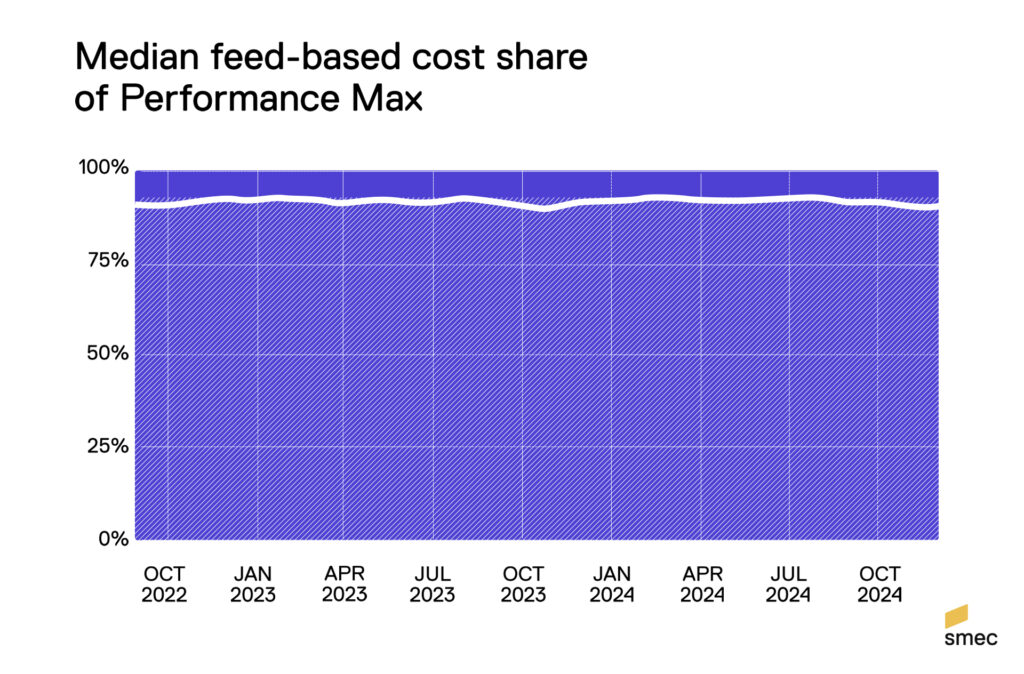
Median cost share of feed-based Performance Max campaigns over time
Source: smec
Key findings:
- Typically between 74% and 97% of PMax costs come from feed-based ads.
- The median value of 90% has been stable, suggesting Google isn’t tweaking this mix.
- Contrary to popular belief, even asset-based Performance Max campaigns are bottom-funnel.
The interplay of Performance Max campaigns & Shopping
A tricky thing about Pmax is that, since it covers many types of ad inventory, Performance Max campaigns theoretically compete with many other types of Google Ads campaigns.
Google’s default guidance has been that campaign conflicts are resolved by ad rank, where ad rank is designed to prevent self-competition by considering factors other than the CPC bid, such as relevance and landing page quality.
However, in the case of keywordless product ads like Shopping, this mechanism doesn’t work. That’s because Shopping ads, whether served by Shopping or Performance Max campaigns, are built with identical assets (the Product Feed), serving identical landing pages. Ad relevance is handled by Google matching products with search terms.

In other words: PMax and Shopping do self-compete when advertising the same products. This can result in bid escalation. The main ways to mitigate this are to:
- Target different products.
- Target different queries (e.g. via negative keywords).
- Set strongly differentiated bids or ROAS targets.
When it comes to Shopping and PMax, you have to clearly choose which foot you want to put forward.
This is crucial considering that, as demonstrated above, PMax typically spends the large majority of its costs on Shopping ads – around 90%!
What about Demand Gen?
Demand Gen and Performance Max campaigns also serve very similar keywordless inventory across YouTube, Google Display, and more.
It’s a bit murkier here, since unlike feed-based product ads, this conflict revolves around the less standardized asset-based portion of PMax. It’s also less threatening in some ways, because PMax typically spends a lot less money on asset-based ads than it does on feed-based ads.
A conflict between PMax and Demand Gen is most threatening to your Demand Gen campaigns: there is the risk that PMax heavily cannibalizes Demand and the campaigns won’t scale.
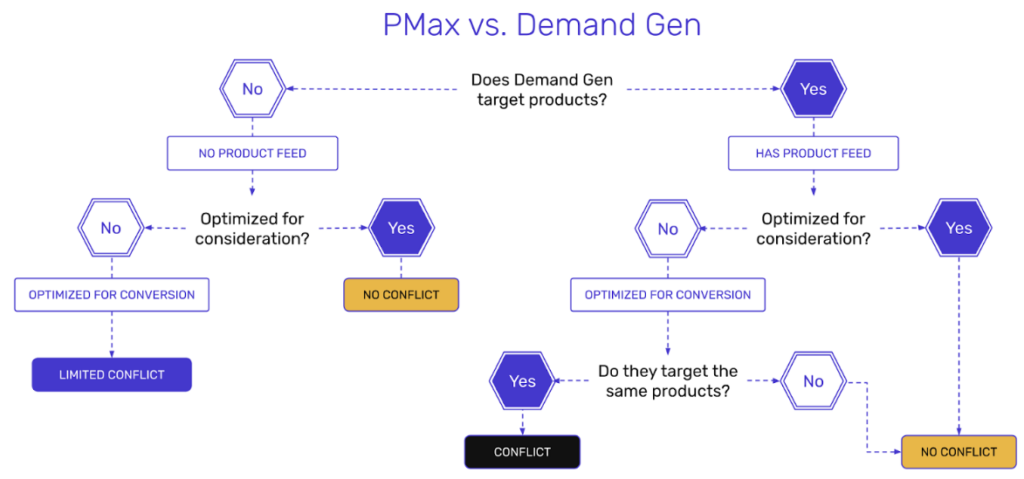
The main differentiator between PMax and Demand Gen is that PMax is bottom-funnel, while Demand Gen can be mid-funnel or bottom-funnel. In other words, your PMax campaigns will always be conversion-oriented, while Demand Gen can optimize for clicks, consideration, soft goals, etc.
When Demand Gen is optimized for conversions, you can end up self-competing, which as stated is more likely to stifle your Demand Gen campaign than cause runaway costs.
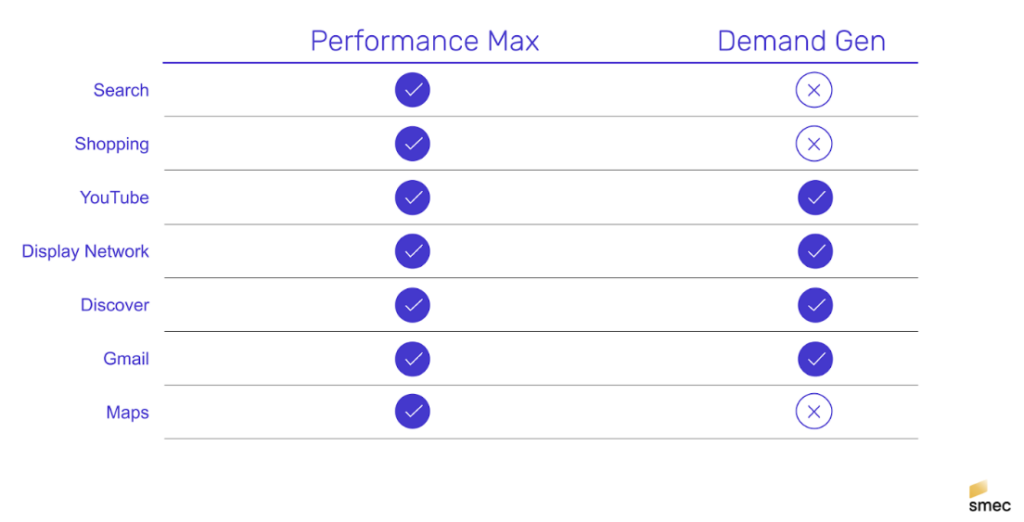
Key findings:
- Ad rank is not always sufficient to prevent self-competition.
- Shopping and Performance Max campaigns will compete on bids when targeting the same products and the same queries.
- PMax can stifle Demand Gen, especially when Demand Gen includes a product feed and is optimized for conversions
“Performance Max and Demand Gen don’t overlap in strategy and focus!”
Thomas Eccel, Head of Google Ads at Jung von Matt IMPACT, leaves us with room for optimism that Demand Gen and PMax will become more differentiated over time:
"While PMax is built to capture & convert existing demand next to Search campaigns, Demand Gen is designed to create new demand through emotional creatives and audience intent.
I think that they share inventory and might overlap (especially DG campaigns that have been set up on warm audiences with tCPA or tROAS leaning towards the lower funnel), however, their purpose is different and they don't overlap in strategy or function.
With the latest Display Network addition for DG, I think Google is drawing a clearer line between mid-high funnel territory of DG and mid-lower funnel territory for PMax to slowly eliminate potential overlaps."

Thomas Eccel
Head of Google Ads
Jung von Matt IMPACT
What about PMax’s impact on Search?
Back in mid 2022 I wrote, “Performance Max is a strange, speckled beast. It is reminiscent of Smart Shopping, Responsive Display, and Dynamic Search all at once.”
Let’s talk about that Dynamic Search part.
Google DSA technology scrapes your web content to automatically generate headlines and matches search queries to relevant landing pages on your website, filling keyword gaps to drive additional traffic.
It has proven increasingly popular with advertisers, and by 2022 DSA was driving >20% of Search spend.
But then everything changed:
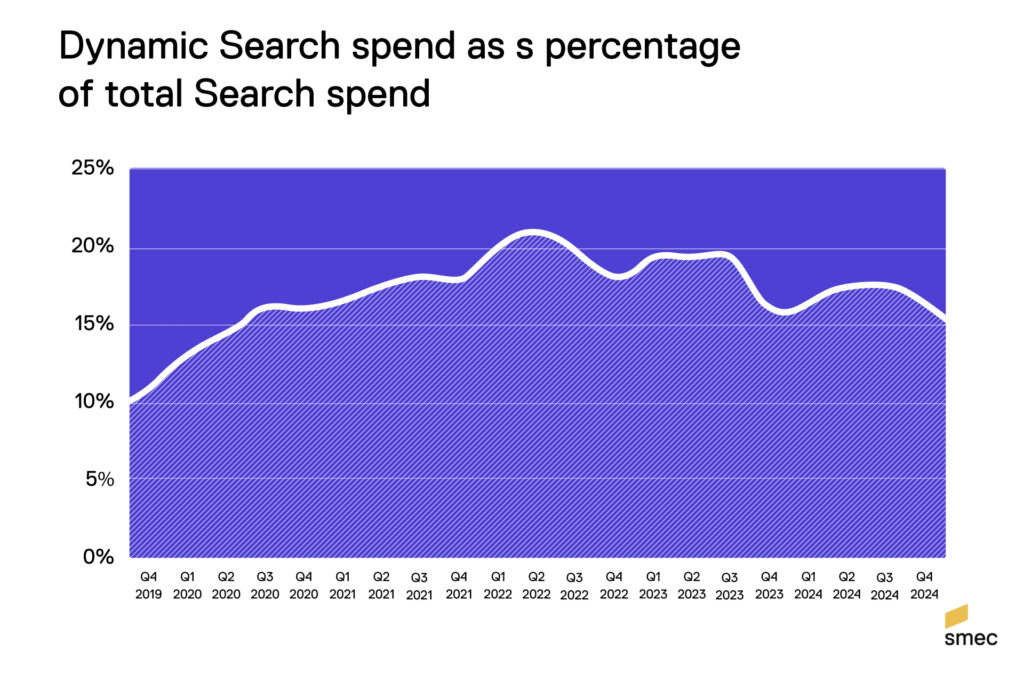
PMax rolled out at scale with a broadly comparable technology called Final URL Expansion. DSA share of spend has been volatile since, but is in a clear state of decline.
This trend is likely to continue: in August 2023 Google introduced a “voluntary upgrade” of DSA to PMax, and now they are offering head-to-head testing to encourage the switch.
Furthermore, Search Engine Land has reported a new technology called Search Max which seems poised to make DSAs redundant. I expect an announcement later this year.
Key findings:
- DSA spend peaked at 21% in Q2 2022, coinciding with the scaled rollout of PMax.
- Its growth trajectory was broken and subsequently lost 5% cost share.
- DSA could see a cost share as high as 30% if PMax hadn’t launched.
- The technology is likely to be deprecated in favor of PMax and Search Max
4. How to make Performance Max work
How many conversions does PMax need to work?
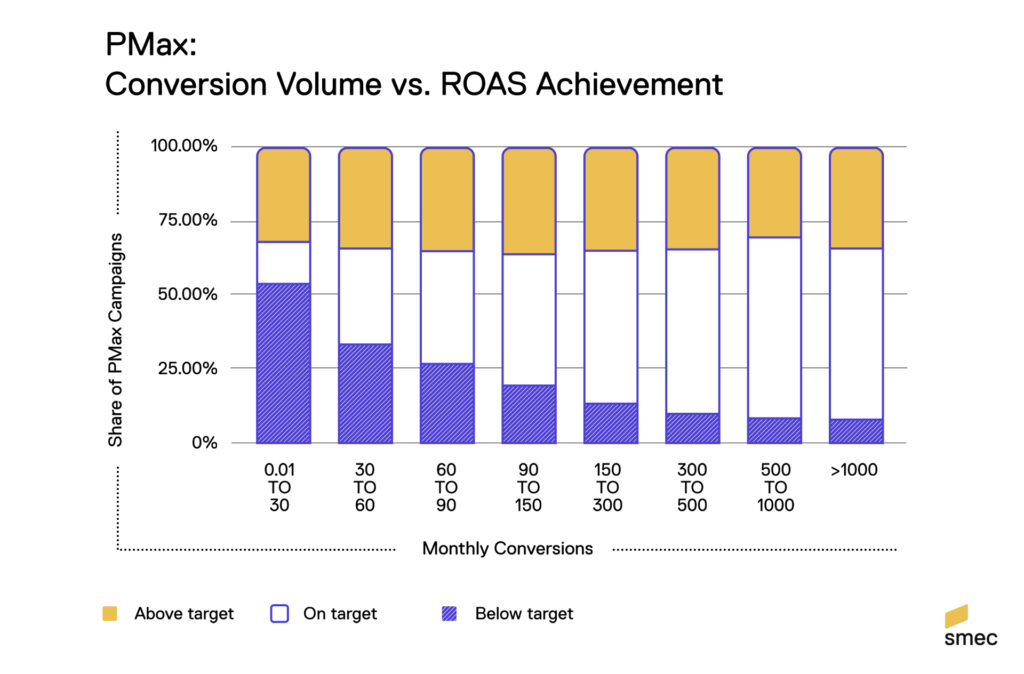
Above you’ll find a highly aggregated view of +4,000 of Performance Max campaigns. But let’s look at how this problem plays out in a single account that has been excessively segmented.
In the chart below, you’ll see Performance Max campaign data from an account that has been structured according to many margin buckets.
The advertiser’s idea is well-intentioned: to set a precise ROAS target for each narrow margin range. In a perfect world, this should help them have more control and advertise more profitably. Suffice to say, we are not living in a perfect world.

Source: smec
Why doesn’t it work? Because this strategy doesn’t consider that products and conversion volume will be distributed unevenly.
As you can see above, some of our advertiser’s Performance Max campaigns have only 1 or 2 monthly conversions, while others have well over 50 – visible along the horizontal axis.
On the vertical axis, you’ll see the difference between actual ROAS and target ROAS, which displays a pretty shocking breadth from nearly -100% to nearly 400%.
It’s important to note that, as campaigns advance in number of monthly conversions, the target ROAS accuracy improves dramatically, while the share of underperforming campaigns dwindles.
So ironically, our advertiser’s desire to achieve extremely precise targets has created a lack of precision in their account.
Key findings:
- Performance Max campaigns need at least 30 monthly conversions, and ideally 60 or more, for optimal performance.
- This is reflected in lower volatility and stronger ROAS target adherence.
- There is no evidence that PMax benefits from cross-campaign learning effects.
- You should avoid excessive segmentation!
How many PMax campaigns should you run?
When PMax launched, we had Google reps telling us and our clients to activate it and go on vacation. This was peak cringe and peak hubris at Google. It really makes me furious to think how reckless that advice was.
Similarly, time and again we saw cases where clients were instructed by Google to run only a single Performance Max campaign.
It’s true that PMax (Smart Bidding, actually) benefits from data consolidation – more on that later. However, account structure is a key way of reflecting your strategy toward Google through different goals and budgets.
That’s why it’s very interesting to see how the number of PMax campaigns per account has developed over time.
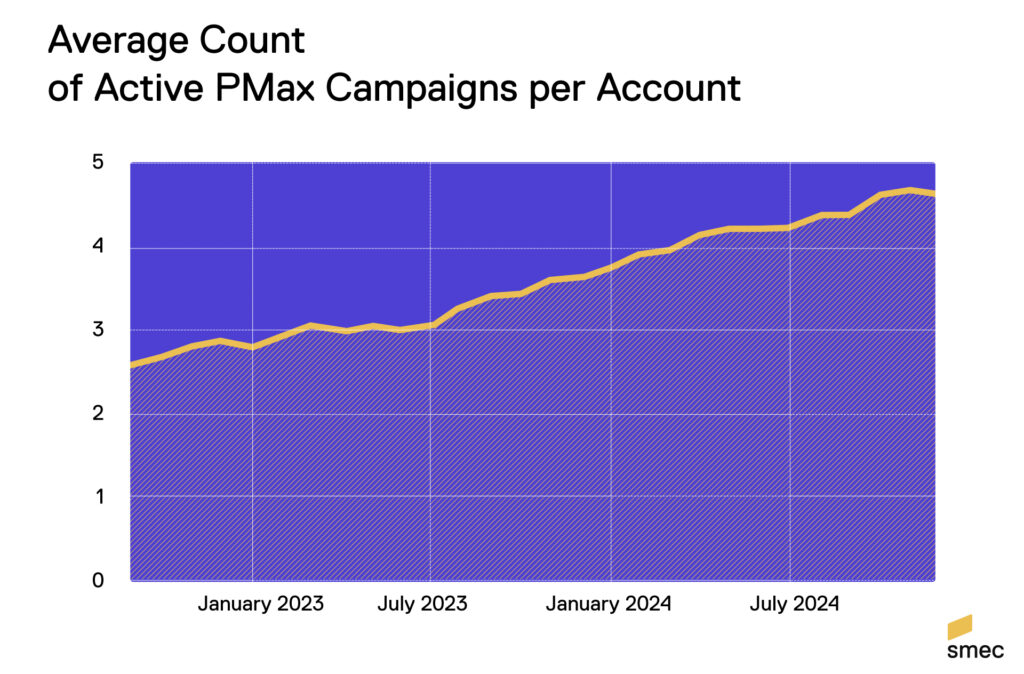
On average, advertisers are now running about twice as many PMax campaigns compared to when PMax fully ramped in September 2022. I view this development as broadly positive, because I take it as a proxy for more sophisticated approaches.
Key findings:
- On average, the number of campaigns per account has nearly doubled.
- There is no “right” number of campaigns: it depends on your conversion volume, the size and variety of your product catalog, and your reasons for segmenting
- 3 to 7 campaigns is a typical range, but just 1 PMax campaign per account remains unfortunately common.
5. Performance Max bidding strategies
How are ecommerce advertisers bidding in PMax?
As a reminder, there are two campaign bid strategies available in Performance Max:
- Maximize Conversions
- Maximize Conversion Values
Each of these volume strategies can optionally have an efficiency goal attached: target CPA and target ROAS, respectively.
The first “version” of the State of PMax was a 2023 twitter thread full of stats I’d been compiling for months. Back then, Maximize Conversion Value (aka “Max Conv. Val”) was highly dominant with a 95% share of Performance Max campaigns.
This makes a lot of sense for ecommerce advertisers who don’t want just orders, but rather bigger orders with larger margins and more valuable shoppers.
However, that was just a snapshot. When we look at a timeline like the one below, an interesting trend becomes visible: the share of campaigns using Max Conversions is growing.
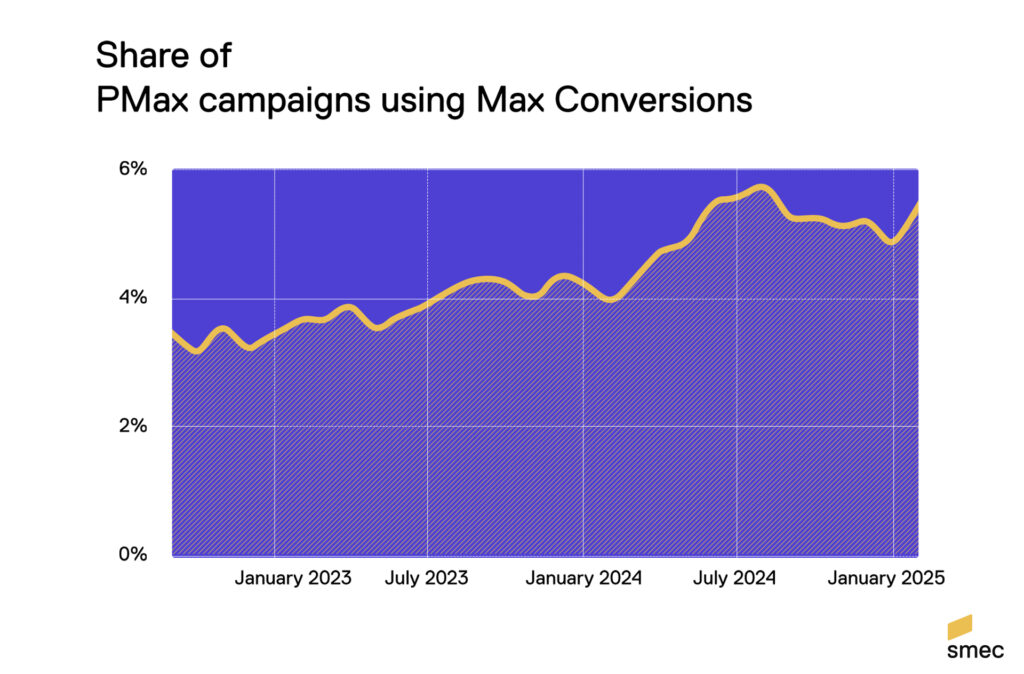
I don’t know exactly how to account for this, and I wouldn’t want to see this trend progress forever. Let’s look quickly at the difference in outcomes between strategies to understand why:
| Bid strategy type | Median CPC | Median conv. rate | Median AOV |
| Max Conv. Value | €0.37 | 2.22% | €106.55 |
| Max Conversions | €0.25 | 1.98% | €22.84 |
Max Conv. Val costs nearly 50% more than Max Conversions.
We’ll look at CPCs in a minute, but higher unit costs are completely fine considering how much bigger the Average Order Values are.
Max Conv. Val does exactly its job in terms of seeking high-value clicks, not just high-conversion clicks. It also delivers pretty strongly on order volume. Max Conversions delivers “only” 20% more conversions, with dramatically smaller outcomes.
You might expect Max Conversions to have a higher conversion rate than Max Conv. Val, but it seems Max Conversions drives conversion volume largely by driving click volume.
Personally, I do not recommend Max Conversions bidding unless you need simply more raw volume to bootstrap your account, or unless your product category has little variety in price point.
Note: this analysis considers only campaigns with ≥30 monthly conversions, because I wanted to reflect data where the algorithm had a “fair chance.”
Key findings:
- Ecommerce advertisers strongly prefer to maximize revenue instead of order volume
- However, this preference is eroding slightly over time, due to unknown reasons
- In general, the Max Conversions bid strategy is suited for new campaigns where the algorithm is signal-thirsty
“Ultimately, I am firmly on team Max Conversion Value”
I asked Navah Hopkins, Brand Evangelist at Optmyzr, on the reasons why she’d choose Max Conversion Value for both ecommerce and lead gen.
"Based on the numbers, Max Conversion Value drove 19,537 euros compared to Max Conversions' 5,116 euro (medians). Additionally, the conversion rate was much better for Max Conversion Value, which I found surprising.
All said and done, it seems a no brainer to go with Max Conversion Value - especially because Google has outright confirmed conversion value and profit metrics are crucial to help it bid effectively.
Yet brands are facing uncertain times and volume that they can nurture with email marketing and subscriptions might meet board room KPIs better than raw revenue. There's also the valid concern around providing too much info to Google (even if it would help them in the long run)."

Navah Hopkins
Brand Evangelist
OPTMYZR
Follow-up:
Are higher CPCs a scam?
In the early days of Google Shopping, advertisers could achieve asymmetric advantages over big-spending competitors by setting smart, granular manual bids (among other tactics). CPC was not only a KPI, but also a core tool.
As of 2022, Smart Bidding had a market share in excess of 80% – in 2025, it’s likely upwards of 90%.
We can no longer directly control our bids, only influence them. And for those who insist on manual bidding, I have one statement and one question: if everyone else in the auction is using Smart Bidding, then your boat is floating on the same tide. Are you sure you’re really in control?
Manual bidding has some edge case applications, but cost per click has become merely an observation metric. As long as there’s no runaway trend, it doesn’t warrant as much scrutiny anymore. If you focus instead on your value per click, and which actions you can take to increase that – this is the way to win.
By the way, Google is doing an admirable job at that:
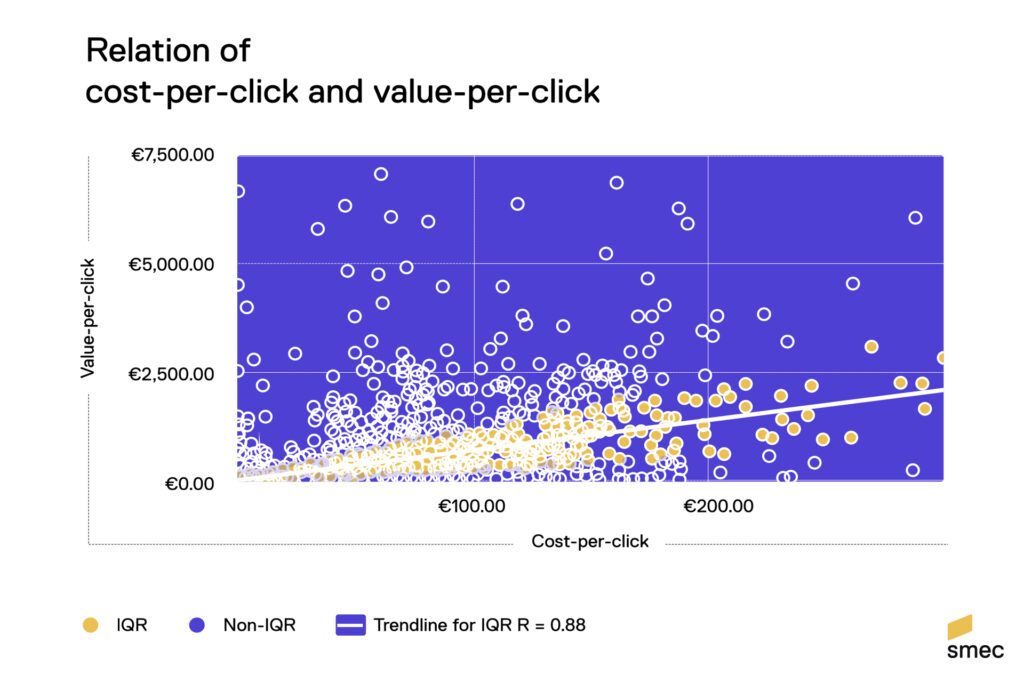
What this chart shows us is that, within the middle 50% of the data (the shaded area), there is a very high correlation, and nearly a linear relationship, between cost per click and value per click.
What’s more: within the outlier data, there are far more high-value “jackpot” outliers than low-value ones. Conspiracy theorists would have you believe that, yes, the click value was high, but you could have bought it cheaper. This actually happens! A lot! The conspiracy is there is no conspiracy.
The only concern in my mind: if Google is so sure this click is high value, how much of that is predictive, and how much is based on history? In other words, they are likely confident in this shopper’s value because they know it – because it’s an existing customer.
The question is: whose customer? Is it your high-value existing customer, or a competitor’s? And how loyal is that customer exactly? Are they really “yours”?
There is much said about Performance Max campaigns, and Google Ads in general, depending on warm traffic and remarketing. I’m increasingly less bothered by this. No, it’s not fun, but it’s the nature of the meatgrinder of competition and often highly price-sensitive customers that we need to get in front of them again and again.
A large majority of shoppers – unfortunately! – are rented, not owned.
Key findings:
- Like it or not, CPCs are owned by Google: we should focus on value per click.
- Smart Bidding is quite effective at bidding correctly based on predicted value.
- The main question that arises is whether or not high value clicks are incremental.
“Incremental revenue growth should be your goal.”
For Caterina Mariani, eCommerce Growth Specialist at PPC Freelance, obsessing over ROAS and conversion value means missing the bigger picture.
"PMax is a unique campaign type that often shows the highest ROAS and conversion value, but there's an important catch.
While these metrics look impressive, PMax typically targets your warmest customers - people already familiar with your brand. Your main goal is increasing incremental revenue (AKA sales that would not have happened otherwise), so don't be misled by pMax's strong performance numbers.
To get the true picture, always cross-check pMax data against your overall business metrics: total revenue, profit, customer acquisition cost (CAC), and average order value (AOV), and if you can, consider third-party MMM
and attribution tools.
This will help you understand if PMax is actually growing your business or just claiming credit for sales that would have happened anyway.”

Caterina Mariani
eCommerce Growth Specialist
PPC FREELANCE
Is turning off Target ROAS a recipe for disaster?
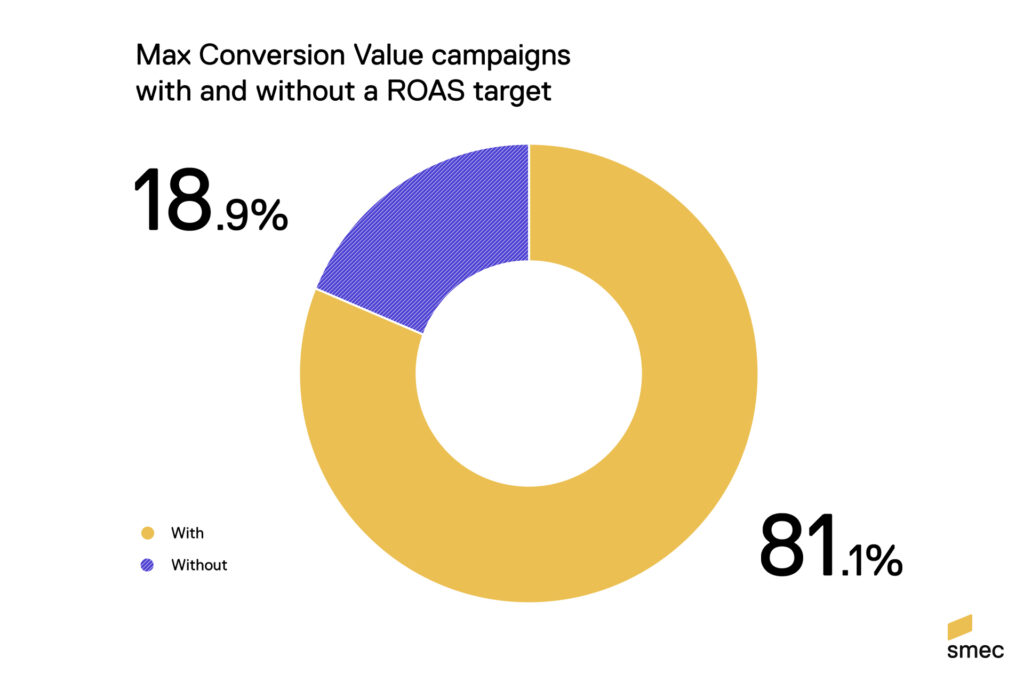
So what exactly happens if you turn off Target ROAS? Many advertisers are concerned that costs will skyrocket and efficiency will plummet catastrophically.
Fortunately, that isn’t the case.
It doesn’t happen because:
- After a ROAS target, your actual ROAS is constrained by budget.
- after your budget, your actual ROAS is constrained by demand.
- and after demand, your actual ROAS is constrained by a hidden failsafe target set by Google.
What will happen are two notable consequences.
First, you will likely see more volatility in your daily and even weekly ROAS. We see this in the chart below:
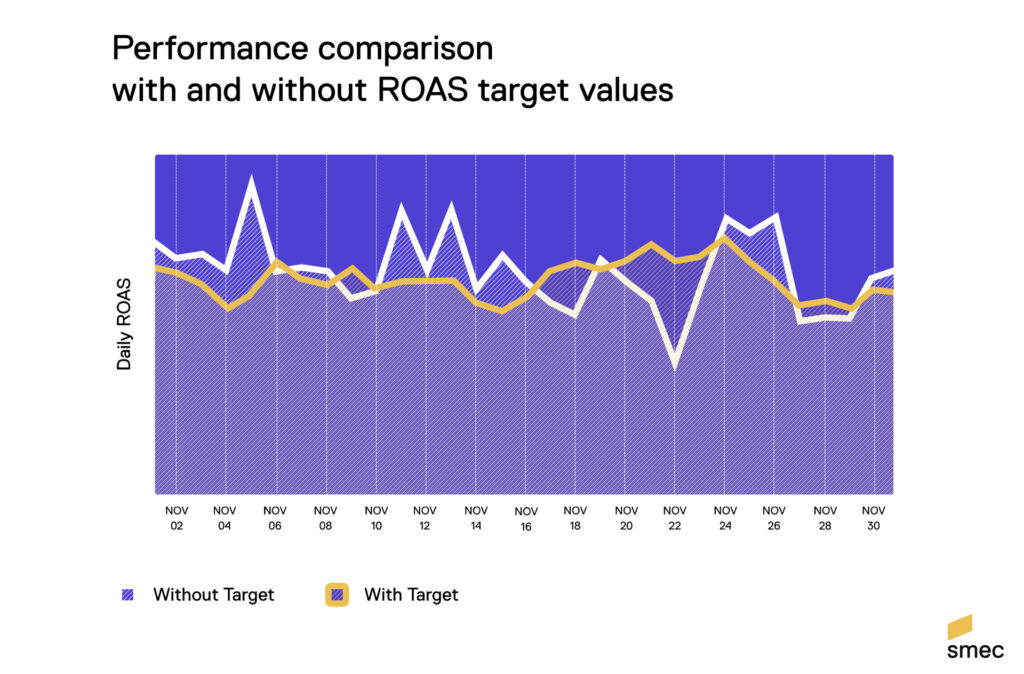
This is a median trend of +5.000 Performance Max campaigns with and without ROAS targets during November 2024. There is substantially more fluctuation in the unbounded campaigns. At the monthly level, campaigns without ROAS targets did perform worse in terms of efficiency, but not catastrophically worse, and in principle the volatility should have been in service of more revenue.
The second (to me, more alarming) consequence is that by forfeiting a ROAS target, you have forfeited one of your last, best levers. I said above that I’m a bit of a ROAS hater. I don’t like in-platform ROAS as an outcome, as a measure of success. To me it is a poor proxy of profitability, and too often advertisers substitute that proxy for the real thing.
If you are interested to learn more about the “No Target ROAS conundrum” in Performance Max campaigns, we’ve covered this topic in more detail in one of our latest episodes of ROASted:
I see the modern value of ROAS more in terms of its ability to create difference between campaigns, to tell the algorithm the level of aggression or conservatism you expect when promoting certain products.
Key findings:
- 9 in 10 ecommerce PMax campaigns use Max Conv. Val bidding, and 8 in 10 of those have a set ROAS target.
- Campaigns without a ROAS target can still deliver a reasonable baseline of performance.
- But campaigns with a ROAS target behave more predictably, with lower volatility.
- And ROAS is one of our best options for communicating with Google’s algorithm.
“Google has been listening to its users.”
Bob Meijer, Google Ads trainer and coach at PPC mastery shares my cautious enthusiasm for how PMax has changed over the past three years and continues to improve.
"I love that Google has been listening to its users and rolled out all sorts of impactful updates lately - negatives, brand exclusions, improved reporting, and more - which gives us more control and insights. The current beta features are looking very promising as well.
Even though Google has vastly improved Performance Max throughout the years, it's still not my go-to campaign type for most of my accounts. I mainly use it in combination with network-specific campaign types (that give me more control, insights, and better results overall), where I use Performance Max as a 'catch-all' layer."

Bob Meijer
Google Ads trainer & coach
PPC Mastery
6. Final thoughts
I… like… PMax. I like PMax.
There! I said it! It wasn’t easy. And it didn’t start that way.
I’m fascinated by exactly how much PMax has changed in positive ways – settings, controls, modifiers, and reports – and how little it has changed in negative ways – no indication that spammy inventory is rising.
I do think that traffic quality is a concern with PMax relative to other campaign types. However, in 2025 we have or are getting the features needed to see those flaws and act on them. Search term reports. Negative keywords. Channel reporting. SPN placements. YouTube placements. App placements. Exclusions.
Traffic quality is therefore the next big horizon in managing PMax. Expect more reports from me on that! 🙂
Many people will tell you I’m wrong!
“The next big thing is MMM, incrementality, etc.” I’ve felt this way in the past and I still do to a certain extent. However, I’m increasingly of the mind that the market is too competitive to get where we might dream. Incrementality is a gradient, a spectrum, not a binary yes/no state. Those who over-optimize towards this will lose market share.
The final thing I want to mention is what I call “PMaxification,” and it’s the reason why, even if you disagree with me, even if you hate PMax and find it rotten to its core – you can’t afford to ignore it.
Eric Seufert famously quipped “everything is an ad network,” which is his way of describing how every platform will become an ad platform, and how every single surface that can be monetized will be.
I like to say “everything is a PMax.” Here’s why:
Google pioneered the idea of end-to-end, platform-managed campaigns by automating bids, automating budget pacing, automating audiences and targeting, automating creatives, and automating placements. In doing so they rolled up channels while slashing reporting and controls. They created a blackbox money machine.
Every digital platform is watching, taking notes, copying.
Google Performance Max. Microsoft Performance Max. TikTok Smart Performance. Meta Advantage+. Amazon Performance+. Pinterest Performance+. And so on.
Firstly, it’s clear this category of technology is the future of digital marketing. Like it or not. I would argue we need to surf the wave, not fight the tide.
Secondly, and more importantly, Google has changed its trajectory. They’ve started cracking open the black box. This should give us hope! Because remember:
Every digital platform is watching, taking notes, copying.
7. Get the PDF!

FAQ:
Performance Max has dominated ad spend—peaking at just under 82% in May 2024. But that golden peak didn’t last. PMax has been losing about 0.65% share per month, totaling nearly 6% drop by early 2025. Advertisers are slowly rediscovering Standard Shopping and Search as viable, sometimes more controllable, options.
PMax is the direct successor to Smart Shopping—Google essentially migrated Smart Shopping into PMax in 2022. This move caused a massive reallocation of ecommerce ad spend. Initially rough around the edges (hello, black box), PMax now has a suite of improved controls: item ID reporting, negative keywords, channel breakdowns, and more. In short, in 2025 it’s no longer “just Smart Shopping with lipstick”—but it still comes with quirks.
Yes, and it’s complicated. In 2025 PMax and Demand Gen can self-compete, especially when both run feed-based creatives optimized for conversions. But their roles differ:
• PMax is bottom-funnel—built to convert.
• Demand Gen is mid-funnel—geared to generate interest.
There’s a grey zone in overlapping placements (YouTube, Gmail, Discovery), but Google is slowly drawing clearer lines between them. If you’re running both, segment goals and audiences carefully.
You can, but you need to be deliberate. PMax and Shopping campaigns do compete—they draw from the same product feed and often bid on the same queries. This can escalate CPCs and waste budget if you’re not careful.
The fix? Use negative keywords, split products across campaign types, or set clear ROAS targets. Just don’t expect them to play nice automatically.
Search isn’t dead—but it’s under pressure in 2025. PMax cannibalizes both brand and non-brand traffic, especially since it uses Final URL Expansion (a DSA-like feature). DSAs themselves are shrinking and might soon get sunset altogether in favor of “Search Max.”
The takeaway? You’ll want to harmonize PMax and Search, especially for brand queries. Page feed strategies and tools like smec’s PMax Brand Traffic Analyzer help ensure you’re not bidding against yourself.
Finally, some good news: negative keywords are in! Alongside channel reporting and placement exclusions, they give advertisers just enough control to fight spammy placements and brand cannibalization. Expect more granularity in 2025—this is Google’s way of trying to win back trust and keep advertisers hooked.

